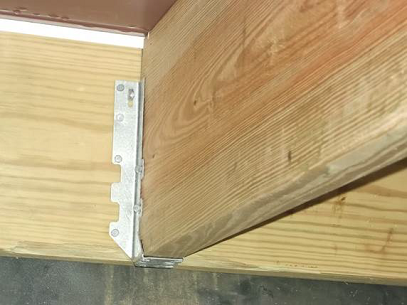|
Home Inspectors Edition | Circulation 20,000 | Advertise | Subscribe | |
Published by OREP, E&O Insurance Experts | December 2013 |
 Click to Read Current Issue |
>
Click to Print
Note: If you live in a “higher-priced” state like
CA, TX, FL, NJ, IL, WA, AZ, OREP does not limit coverage or raise rates on you. Same rates apply in all states
where this program is offered.
>
Approved Inspector Continuing Education at
Discount
|
As part of a home inspection, a deck should be checked for various
things, such as structural integrity, railing size and strength,
hardware type and condition, and staircase issues.
Deck Inspections - Part I
By Matthew Steger, ACI, WIN Home Inspection
Many homes have decks attached to them for entertaining and
relaxing under the stars, but most homeowners do not perform a
regular deck inspection. Each year, people are injured or
killed due to faulty construction or the lack of needed regular
maintenance of decks.
According to statistics, there are 40 million decks in the U.S.
that are over 20 years old. Since the year 2000, the number of
injuries and deaths related to deck failures has been increasing
according to the North American Deck and Railing Association
(NADRA). The typical life expectancy of a wood deck is
usually 15-20 years, assuming regular maintenance. Nothing
lasts forever, and any wooden structure exposed to the elements
24/7 will require regular maintenance and inspection to ensure
safe usage and long life.
As part of a home inspection, a deck should be checked for various
things, such as structural integrity, railing size and strength,
hardware type and condition, and staircase issues.
Support Columns
Starting at the ground, look at the size, number, and condition of
the support columns or piers. 4x4 and 6x6 pressure treated
lumber is used in most modern decks to secure the deck to the
ground. Anything less than 4x4 posts probably won’t be able
to properly support the deck and its occupants. I’ve
inspected a few decks over 8 feet above ground that were only
supported with 3x3 posts at the corners which are considered
inadequate. Decks should typically be designed for at least
a 40 pound per square foot load. If a hot tub will be added,
for example, the deck’s structure will need to be beefed up to
safely carry the extra load of the hot tub and the water in the
hot tub. This may mean larger or more numerous joists, extra
bracing and/or support columns, etc. Remember that a gallon
of water weighs 8 lbs.
The deck’s hardware and footings must form a continuous load path
into the ground to provide a strong reliable deck. The
wooden support columns or piers can be cemented into the ground or
a metal bracket can connect the concrete pier to the bottom of the
wooden columns. Keeping the wood and cement/ground away from
each other can help prevent future rot. A rotted support
pier can compromise the rest of the deck. The concrete pier
should continue underground below the frost line, typically at
least 3’ in south central PA. Without digging (which home
inspectors don’t do), the depth of the pier (concrete or wood)
underground is most often unknown. Lumber that enters the
ground must be rated for ground contact and properly preserved
(including adding preservative onsite to the exposed interior
grain once the lumber is cut).
Check the wooden columns and joists for excessive cracks or
rusting/deterioration of the metal hardware used to hold the
components together. Most older decks have the wooden
support posts simply installed into the ground.
The photo below shows a metal bracket secured into the concrete
pier (below it) and secured to the wooden deck support column
(above it). The wood pier and the earth do not ever make
direct contact.

Also, the home’s downspouts, sump pump, and the grading under
the deck should drain away from the deck to help minimize the
chances of wood rot as well as insect or rodents being attracted
to the area around the deck.
Fasteners
Most decks are attached to a home and most of the decks that I
inspect lack proper fasteners or hardware. Older decks
routinely had their ledger boards only nailed to the home.
Nails are not designed for shearing loads and often come loose
over time. The ledger board is the part of the deck where
the floor joists connect on the home’s side. Modern
standards require a proper and durable connection between the
home and the deck, such as using lag bolts or carriage bolts.
With a proper connection, the home helps hold the deck up.
An improper connection can allow the deck to fall off the home
which will likely injure (or possibly kill) whomever is standing
on the deck at the time. If your deck’s ledger board is
only nailed to the home, a qualified deck contractor can most
often add lag or carriage bolts to better secure the deck to the
home. Also, brick or stone veneers are not permitted to be
used to support a deck as these types of exterior cladding
materials are not structural. Attaching a deck to a home
covered with stucco (real or synthetic) can be quite difficult
and preventing water entry into the home can take considerable
thought and effort.
A free-standing deck is another option in most cases. This type
of deck is not attached to or supported by the home but merely
is fastened into the ground adjacent to the home with piers.
Since the deck and home don’t touch, flashing isn’t needed and
therefore water penetration into the home at this area is much
less likely. Since a free-standing deck has to fully
support itself independently, additional structural bracing is
required for this type of deck.
To construct the rest of the deck’s various structural components (piers, girders, joists, etc.) together, proper metal hardware is a must to ensure strength and long life. Proper bolts and screws are preferred over nails when building a deck. As mentioned above, nails are not designed for shearing loads and can come loose over time, whereas bolts and screws will tend to provide a much more reliable and longer lasting connection. Hot dipped galvanized or stainless hardware should be used, the latter is more expensive but is most often used on decks near the ocean due to salt water deterioration of fastener plating.

The photo above shows a wooden girder under a deck that is
merely sitting on top of wooden piers and the girder is only
fastened to the piers using short 2x4s and 8 screws. This
is an inadequate mechanical connection. There are no bolts
to secure the deck’s structure together. Ideally, the
piers should have had a pocket or notch cut in them to allow the
girder to rest on the pier and allow bolts to secure everything
together. This particular deck was mostly relying on
gravity to stay in place. Settlement or erosion of the
grounds around the deck could lead to a deck failure.
This article will be continued in Deck
Inspections - Part 2 in Working RE's next Home
Inspection Newsletter.
About the Author
Matthew Steger, owner/inspector of
WIN Home Inspection, is a
Certified Level 1 Infrared Thermographer and an ASHI Certified
Inspector (ACI). He can be reached at: 717-361-9467 or
msteger@wini.com.
ATTENTION: You are receiving WRE Online News because you opted in at WorkingRE.com or purchased E&O insurance from OREP. WRE Online News Edition provides news-oriented content twice a month. The content for WRE Special Offer Editions is provided by paid sponsors. If you no longer wish to receive these emails from Working RE, please use the link found at the bottom of this newsletter to be removed from our mailing list.





